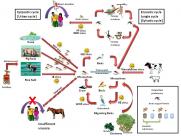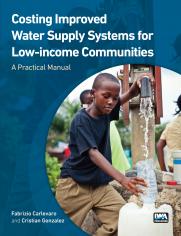 The Zika virus: we should expect more like it!
The Zika virus: we should expect more like it!
Robert Armon, author of the comprehensive book: Environmental Aspects of Zoonotic Diseases (2012), sheds light on the global problem of flaviviruses such as Zika. He notes that this recently publicised disease is just one example of many severe viruses that could flourish in the right environmental conditions.
Supplement to Impacts of Climate Change on Rainfall Extremes and Urban Drainage Systems
This electronic supplement was originally hosted on the WaterWiki page. It accompanies the IWA publication Impacts of Climate Change on Rainfall Extremes and Urban Drainage Systems.
 Costing Improved Water Supply Systems for Low-income Communities - Water Supply Costing Processor Tool
Costing Improved Water Supply Systems for Low-income Communities - Water Supply Costing Processor Tool
This free downloadable Excel-based costing tool is designed to be used with its manual which can be purchased...
Coagulation and Flocculation in Water and Wastewater Treatment
Coagulation and flocculation are an essential part of drinking water treatment as well as wastewater treatment. This article provides an overview of the processes and looks at the latest thinking.
A Brief History of Water and Health from Ancient Civilizations to Modern Times
Water is life – and life on earth is linked to water. Our existence is dependent on water, or the lack of it, in many ways, and one could say that our whole civilization is built on the use of water. This article examines the influence of water on public health throughout history. Farming and the development of settlements lead to the beginning of the problem that faces mankind today – how to get drinkable water for humans and cattle and how to manage the waste we produce. The availability of water in large quantities has been considered an essential part of civilization throughout the different periods: Roman baths needed a lot of water, as do the water closets and showers used in current Western civilization. The importance of good quality drinking water has been established for years. However, the importance of proper sanitation was not understood until the 19th century.
Flood Control and Disaster Management
Flood control refers to all methods used to reduce or prevent the detrimental effects of flood waters (wikipedia). Some of the common techniques used for flood control are installation of rock berms, rock rip-raps, sandbags, maintaining normal slopes with vegetation or application of soil cements on steeper slopes and construction or expansion of drainage channels. Other methods include levees, dikes, dams, retention or detention basins. After the Katrina Disaster that happened in 2005, some areas prefer not to have levees as flood controls. Communities preferred improvement of drainage structures with detention basins near the sites.
Disaster Management
Disaster management plans are multi-layered and are aimed to address such issues as floods, hurricanes, fires, bombings, and even mass failures of utilities or the rapid spread of disease. The disaster plan is likely to address such as important matters as relinquishing people from an impacted region, arranging temporary housing, food, and medical care.
Rainwater - Why is it Safe?
There are so many misconceptions in the world – and rainwater is no exception. When people think of rainwater, they often think of wastewater, pollutants and even balding! Do you think these ideas are accurate? Whilst such concerns might stem from a common misunderstanding, we seem to accept them as scientific fact. In this chapter, the truth will be exposed: rainwater is actually extremely clean and safe.
Water-based diseases
Waterborne diseases are caused by pathogenic microorganisms which are directly transmitted when contaminated fresh water is consumed. Contaminated fresh water, used in the preparation of food, can be the source of foodborne disease through consumption of the same microorganisms. According to the World Health Organization, diarrheal disease accounts for an estimated 4.1% of the total DALY (diability-adjusted life year) global burden of disease and is responsible for the deaths of 1.8 million people every year. It was estimated that 88% of that burden is attributable to unsafe water supply, sanitation and hygiene, and is mostly concentrated in children in developing countries.
Up Flow - Anaerobic Sludge Blanket Reactor (UASB)
Up flow anaerobic sludge blanket technology also known as UASB reactor is a form of anaerobic digester which used in wastewater treatment. UASB reactor is a methane-producing digester, which uses an anaerobicprocess and forming a blanket of granular sludge and is processed by the anaerobic microorganisms.